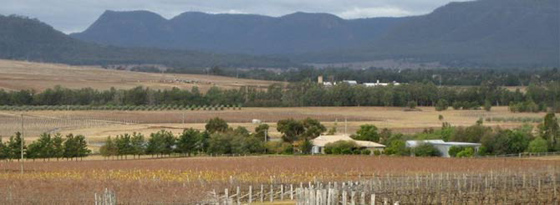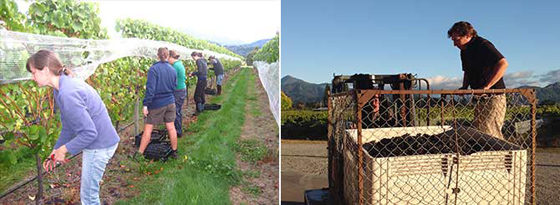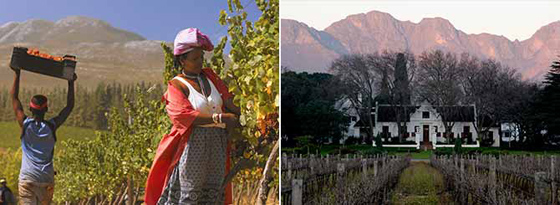Date£º
2014-05-22 09:49 Source£º
winesearcher Author:
Wine-Searcher staff and contributors Translator:
In part 2 of our Southern Hemisphere 2014 vintage report, we head to the rugby-loving nations of Australia, New Zealand and South Africa.

Australia's Hunter Valley
Australia by Mike Bennie
Quantity is down but quality is up according to growers, as Australia's 2014 harvest comes to a close.
The last fruit has been picked across Australia's 60-odd designated wine regions, with a sense that a difficult vintage nevertheless produced high-quality grapes from reduced yields.
The Hunter Valley started traditionally early, with young Semillon fruit being picked in the first and second weeks of January after a fine growing season.
"Awesome vintage," Thomas Wines winemaker Andrew Thomas reports. "Warm and dry throughout, apart from some very welcome rain during the growing season in November. Good yields of ripe, concentrated fruit and both Semillon and Shiraz are looking outstanding. Both are beautifully structured and will provide excellent early drinking as well as long-term cellaring potential."
It was more difficult in the cooler Yarra Valley of Victoria. "It was a challenging season; a terrible spring with poor flowering due to windy, cold, wet weather, then a touching up of frost added insult to injury," according to Oakridge winemaker David Bicknell. "Then a couple of heat-spikes in January caused further damage."
Yields were low, though Bicknell says what has been picked ?at great cost ?is of exceptional quality.
The Barossa Valley has had a more moderate 2014 harvest and winemaker John Duval "the former doyen of Penfold's wines, who now produces noteworthy wines under his own label -says the season was "not quite a 2010 or 2012, but 2014 has produced some very nice wines".
"A hot start to 2014 brought on an early start to vintage, but significant rain in the second week of February slowed picking and gave the vines a much-needed break from the heat. Canopies were rejuvenated and the ripening period significantly extended," he says.
Margaret River seems to have had an unnervingly consistent decade of vintages and that continues in 2014. According to Vanya Cullen of Cullen Wines it has been a "classic vintage with an early start, and a late finish for those with higher yields. A great harvest for Semillon and Cabernet Sauvignon." Conditions in Margaret River started with rains that stopped during late December before the warm, dry late summer started, producing a vintage Cullen suggests will again be excellent for most producers.
Anecdotally, harvests across Australia seemed to be for the most part early, though Tasmania was decidedly late.

Mahi | Mahi Vineyard in Marlborough had an early harvest
New Zealand by Rebecca Gibb
There's going to be more New Zealand wine than ever before with some estimates putting the crop at a record 400,000 tonnes (441,000 tons).
That's more than 55,000 tonnes greater than the Kiwi wine industry has ever produced but, thankfully, it looks like it's going to be pretty tasty and, with exports also reaching record highs, another wine glut is hopefully not on the cards.
Across both the North and South Islands, a warm spring got things off to a speedy start. The warm and dry weather continued throughout the summer, minimizing disease pressure. The country basked in yet another glorious summer and the only ones complaining were dairy farmers.
In the country's major viticultural region, Marlborough, Mahi's Brian Bicknell says: "One of things that will be remembered about the 2014 vintage was the very early start and finish. I remember remarking about the same thing last year but this one was even more precocious and it was a bit of a panic with barrel orders and staff arrivals."
The major weather event to hit New Zealand over the summer was the tail of Cyclone Lusi in mid-March. While the local media stirred up a frenzy over the coming storm, it turned out to be little more than a windy weekend for many.
Larry McKenna of Escarpment in Martinborough says: "We had a dream run. The crux was that Lusi went down the west coast not the east coast and if we had had a week of wet weather it would have been a different story.
"We finished everything off before Easter -that's the first time ever in 30 years. In 2012 we started only two days earlier than we finished in 2014."
And with all the wine safely tucked away, he's pretty confident about the quality. "It's as good as 2013. I don't want to say whether it's better, but it looks very similar."That's a big call when most producers in New Zealand were hailing 2013 as the vintage of a lifetime.
Heading southward to Pinot-focused Central Otago, the country's only continental wine-producing region, growing seasons can be completely different to the rest of the maritime-influenced regions. However, they are equally excited about the fruit arriving at the winery. "There's nothing to suggest this can't be as good as anything we have ever made,?says Blair Walter, winemaker at Felton Road.
After an early warm spring, the summer months were a little cooler than average, allowing ripening to take its time. Bunch weights are reportedly small, boding well for color and structure.
"This is the closest that I have seen to 2012, which we regard as our best vintage,"explains Walter. "The wines will be a little deeper-textured and richer than in 2012."

Charmaine Grieger/WOSA/Nederburg | South Africa's vintage was smaller than last year
South Africa by Wine Searcher staff
Despite a challenging season characterized by high, often untimely rainfall, the South African wine industry expects an average-sized, good-quality wine grape harvest, with exceptional harvests in the coastal regions, according to VinPro, the representative organization for close to 3600 South African wine producers.
The harvest commenced later than normal, due to late, cold winter conditions and a cooler spring. High rainfall mid-November and in January led to producers having to irrigate much less, but applying stricter disease control measures at higher input costs to limit losses.
Above-average yields of exceptional quality were obtained in the coastal regions, while irrigated areas also achieved good crops despite loss due to rot.
However, the Orange River experienced the greatest frost damage in years, which had a substantial effect on the harvest.
The total harvest will be approximately 2.6 percent smaller than the record harvest in 2013 and consumers can look forward to high-quality wines from the 2014 harvest year.
"March was a challenging month to schedule picking due to the high demand for labour in the field as a result of the bumper crop, coupled with heavy rains late in the month, which disrupted harvest planning"says Adam Mason, winemaker at Mulderbosch Vineyards in Stellenbosch.
"Given the early ripeness levels across the board however, 2014 was definitely not the season to hold back and wait for extra hang time. In general, I am excited by the quality from the dryland bushvines we harvested, and expect plush, generous red wines with early approachability."
Eben Sadie, of Sadie Family Wines in Swartland, says the speed of the vintage caught some producers unawares.
"The only aspect that did trouble the harvest was the fact that the bigger canopies and bigger water resource resulted in the vintage kicking off 10-14 days on average later than usual,"he said.
"But then, once the warmer February came, everything accelerated and everything practically ripened in a space of 18 days and all the producers had to pick frantically to keep up. For those that did manage to keep up and get things done on time, the result should be true greatness. Never have we picked our 54 parcels in a space of three-and-a-half weeks and I honestly hope to never again!"